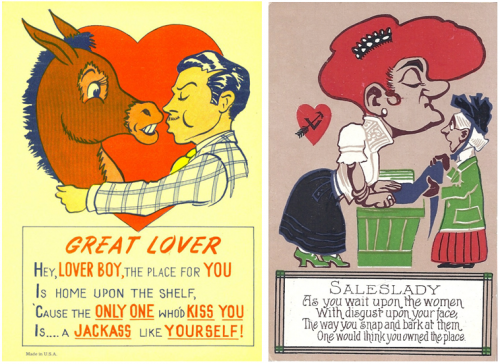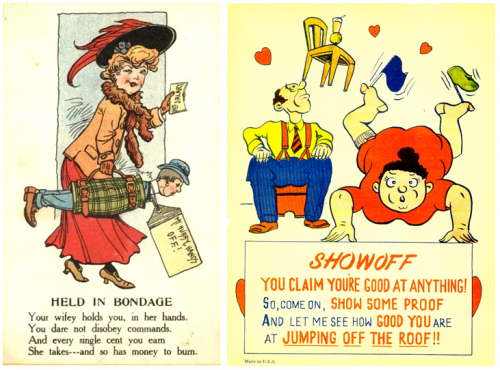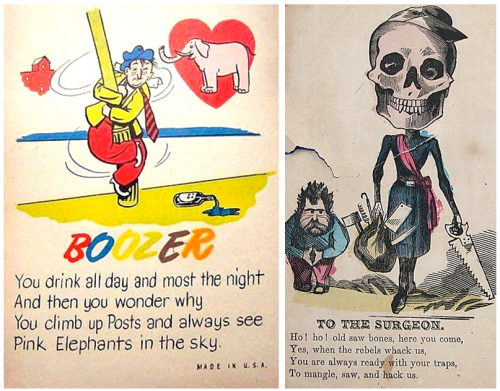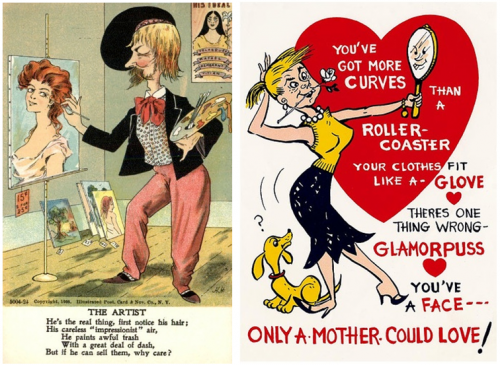For 100 years Valentine’s Day was not only associated with sweet sentiments, but was an occasion to send a cruel and biting message to someone you didn’t like. These cards — called “vinegar valentines” — were popular from 1840 to 1940 in both America and the U.K.
 Annebella Pollen, an art and design historian who talks about the valentine’s at Collector’s Weekly, explains that there was a valentine for many types of people and occasions:
Annebella Pollen, an art and design historian who talks about the valentine’s at Collector’s Weekly, explains that there was a valentine for many types of people and occasions:
You could send them to your neighbors, friends, or enemies. You could send them to your schoolteacher, your boss, or people whose advances you wanted to dismiss. You could send them to people you thought were too ugly or fat, who drank too much, or people acting above their station. There was a card for pretty much every social ailment.
Pollen insists that people did send them to one another, albeit anonymously, and they were not meant to be jokes. Instead, they were meant to say: “Your behavior is unacceptable.” For much of the 1800s there was no such thing as a pre-paid stamp, so the person who got the mail paid for it, so often they were forced to buy their own insults, a twist of the knife from the sender.
Many, many more vinegar valentine’s at Collector’s Weekly, where I also stole this great title. Via BoingBoing.
Lisa Wade, PhD is an Associate Professor at Tulane University. She is the author of American Hookup, a book about college sexual culture; a textbook about gender; and a forthcoming introductory text: Terrible Magnificent Sociology. You can follow her on Twitter and Instagram.



Comments 8
Rishi — February 14, 2013
What a delightful tradition! We should revive it.
Merry — February 14, 2013
These seem so perfect for internet-culture. All I can think is that it's complete ownage which I didn't realize was even *a thing* so long ago. They're just so sassy.
Christian Stalley — February 12, 2014
Very interesting article, about which I knew nothing! Thank you for showing it. However, please do one final edit before you publish, as throughout you have used apostrophes in plurals. Unless you were trying to handle the possessive of Valentine's when pluralizing Valentine's cards. I think in this situation you just have to use either Valentine's cards, or Valentines'.
WEEKEND RAGE LINKS – MADDD GRRRL — February 14, 2014
[…] VINTAGE VINEGAR VALENTINES No rage here, just for fun. Sending snarky Valentines (in the grand tradition of MADDD GRRRL-grams) has always been a thing! Though, actually, rage away, some of these are pretttttttty misogynist… […]
Sadia Sultana — February 13, 2015
VALENTINES DAY images and gift
http://tinyurl.com/VDG-I2015
http://tinyurl.com/VDG-I2015
http://tinyurl.com/VDG-I2015
VALENTINES DAY images and gift
http://tinyurl.com/VDG-I2015
http://tinyurl.com/VDG-I2015
http://tinyurl.com/VDG-I2015
VALENTINES DAY images and gift
http://tinyurl.com/VDG-I2015
http://tinyurl.com/VDG-I2015
http://tinyurl.com/VDG-I2015
VALENTINES DAY images and gift
http://tinyurl.com/VDG-I2015
http://tinyurl.com/VDG-I2015
http://tinyurl.com/VDG-I2015
VALENTINES DAY images and gift
http://tinyurl.com/VDG-I2015
http://tinyurl.com/VDG-I2015
http://tinyurl.com/VDG-I2015
VALENTINES DAY images and gift
http://tinyurl.com/VDG-I2015
http://tinyurl.com/VDG-I2015
http://tinyurl.com/VDG-I2015
VALENTINES DAY images and gift
http://tinyurl.com/VDG-I2015
http://tinyurl.com/VDG-I2015
http://tinyurl.com/VDG-I2015
VALENTINES DAY images and gift
http://tinyurl.com/VDG-I2015
http://tinyurl.com/VDG-I2015
http://tinyurl.com/VDG-I2015
VALENTINES DAY images and gift
http://tinyurl.com/VDG-I2015
http://tinyurl.com/VDG-I2015
http://tinyurl.com/VDG-I2015
VALENTINES DAY images and gift
http://tinyurl.com/VDG-I2015
http://tinyurl.com/VDG-I2015
http://tinyurl.com/VDG-I2015
VALENTINES DAY images and gift
http://tinyurl.com/VDG-I2015
http://tinyurl.com/VDG-I2015
http://tinyurl.com/VDG-I2015
VALENTINES DAY images and gift
http://tinyurl.com/VDG-I2015
http://tinyurl.com/VDG-I2015
http://tinyurl.com/VDG-I2015
VALENTINES DAY images and gift
http://tinyurl.com/VDG-I2015
http://tinyurl.com/VDG-I2015
http://tinyurl.com/VDG-I2015
VALENTINES DAY images and gift
http://tinyurl.com/VDG-I2015
http://tinyurl.com/VDG-I2015
http://tinyurl.com/VDG-I2015
VALENTINES DAY images and gift
http://tinyurl.com/VDG-I2015
http://tinyurl.com/VDG-I2015
http://tinyurl.com/VDG-I2015
VALENTINES DAY images and gift
http://tinyurl.com/VDG-I2015
http://tinyurl.com/VDG-I2015
http://tinyurl.com/VDG-I2015
VALENTINES DAY images and gift
http://tinyurl.com/VDG-I2015
http://tinyurl.com/VDG-I2015
http://tinyurl.com/VDG-I2015
VALENTINES DAY images and gift
http://tinyurl.com/VDG-I2015
http://tinyurl.com/VDG-I2015
http://tinyurl.com/VDG-I2015
VALENTINES DAY images and gift
http://tinyurl.com/VDG-I2015
http://tinyurl.com/VDG-I2015
http://tinyurl.com/VDG-I2015
VALENTINES DAY images and gift
http://tinyurl.com/VDG-I2015
http://tinyurl.com/VDG-I2015
http://tinyurl.com/VDG-I2015
Sadia Sultana — February 13, 2015
VALENTINES DAY images and gift
http://tinyurl.com/VDG-I2015
http://tinyurl.com/VDG-I2015
http://tinyurl.com/VDG-I2015
VALENTINES DAY images and gift
http://tinyurl.com/VDG-I2015
http://tinyurl.com/VDG-I2015
http://tinyurl.com/VDG-I2015
VALENTINES DAY images and gift
http://tinyurl.com/VDG-I2015
http://tinyurl.com/VDG-I2015
http://tinyurl.com/VDG-I2015
VALENTINES DAY images and gift>>>>>>>>>>
http://tinyurl.com/VDG-I2015
http://tinyurl.com/VDG-I2015
http://tinyurl.com/VDG-I2015
VALENTINES DAY images and gift
http://tinyurl.com/VDG-I2015
http://tinyurl.com/VDG-I2015
http://tinyurl.com/VDG-I2015
VALENTINES DAY images and gift
http://tinyurl.com/VDG-I2015
http://tinyurl.com/VDG-I2015
http://tinyurl.com/VDG-I2015
VALENTINES DAY images and gift
http://tinyurl.com/VDG-I2015
http://tinyurl.com/VDG-I2015
http://tinyurl.com/VDG-I2015
VALENTINES DAY images and gift
http://tinyurl.com/VDG-I2015
http://tinyurl.com/VDG-I2015
http://tinyurl.com/VDG-I2015
VALENTINES DAY images and gift
http://tinyurl.com/VDG-I2015
http://tinyurl.com/VDG-I2015
http://tinyurl.com/VDG-I2015
VALENTINES DAY images and gift
http://tinyurl.com/VDG-I2015
http://tinyurl.com/VDG-I2015
http://tinyurl.com/VDG-I2015
VALENTINES DAY images and gift
http://tinyurl.com/VDG-I2015
http://tinyurl.com/VDG-I2015
http://tinyurl.com/VDG-I2015
VALENTINES DAY images and gift
http://tinyurl.com/VDG-I2015
http://tinyurl.com/VDG-I2015
http://tinyurl.com/VDG-I2015
VALENTINES DAY images and gift
http://tinyurl.com/VDG-I2015
http://tinyurl.com/VDG-I2015
http://tinyurl.com/VDG-I2015
VALENTINES DAY images and gift
http://tinyurl.com/VDG-I2015
http://tinyurl.com/VDG-I2015
http://tinyurl.com/VDG-I2015
VALENTINES DAY images and gift
http://tinyurl.com/VDG-I2015
http://tinyurl.com/VDG-I2015
http://tinyurl.com/VDG-I2015
VALENTINES DAY images and gift
http://tinyurl.com/VDG-I2015
http://tinyurl.com/VDG-I2015
http://tinyurl.com/VDG-I2015
VALENTINES DAY images and gift
http://tinyurl.com/VDG-I2015
http://tinyurl.com/VDG-I2015
http://tinyurl.com/VDG-I2015
VALENTINES DAY images and gift
http://tinyurl.com/VDG-I2015
http://tinyurl.com/VDG-I2015
http://tinyurl.com/VDG-I2015
VALENTINES DAY images and gift
http://tinyurl.com/VDG-I2015
http://tinyurl.com/VDG-I2015
http://tinyurl.com/VDG-I2015
VALENTINES DAY images and gift
http://tinyurl.com/VDG-I2015
http://tinyurl.com/VDG-I2015
http://tinyurl.com/VDG-I2015
Valentine’s Day Amazing Facts | — March 5, 2016
[…] See more of these heart day jabs […]
Bob — March 24, 2020
I... can't... handle... my... SWAG!!!!!!! OHHH YEAHHHH IMA POTATO!!!!!